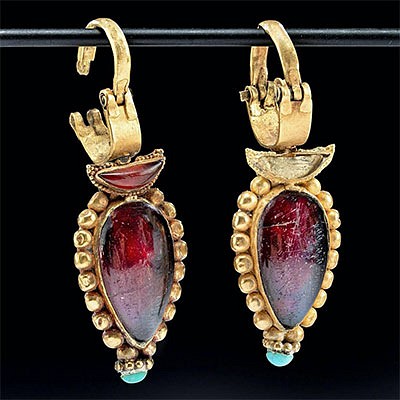Four 18th C. Indo-Persian Illustrated Manuscript Pages
Lot 141
About Seller
Artemis Fine Arts
686 S Taylor Ave, Ste 106
Louisville, CO 80027
United States
Selling antiquities, ancient and ethnographic art online since 1993, Artemis Gallery specializes in Classical Antiquities (Egyptian, Greek, Roman, Near Eastern), Asian, Pre-Columbian, African / Tribal / Oceanographic art. Our extensive inventory includes pottery, stone, metal, wood, glass and textil...Read more
Categories
Estimate:
$1,200 - $1,500
Absentee vs Live bid
Two ways to bid:
- Leave a max absentee bid and the platform will bid on your behalf up to your maximum bid during the live auction.
- Bid live during the auction and your bids will be submitted real-time to the auctioneer.
Bid Increments
| Price | Bid Increment |
|---|---|
| $0 | $25 |
| $300 | $50 |
| $1,000 | $100 |
| $2,000 | $250 |
| $5,000 | $500 |
| $10,000 | $1,000 |
| $20,000 | $2,500 |
| $50,000 | $5,000 |
| $100,000 | $10,000 |
| $200,000 | $20,000 |
About Auction
By Artemis Fine Arts
Nov 11, 2021
Set Reminder
2021-11-11 12:00:00
2021-11-11 12:00:00
America/New_York
Bidsquare
Bidsquare : It's a Small World | Diminutive Artifacts
https://www.bidsquare.com/auctions/artemis-gallery/its-a-small-world-diminutive-artifacts-7836
Join us for a very special auction featuring art & artifacts from East to West, North to South, and everywhere in between - with one small thing in common - size! Everything in this auction is approximately 6 inches or less - perfect for that last bit of shelf space in your curio cabinet! Artemis Fine Arts info@artemisfinearts.com
Join us for a very special auction featuring art & artifacts from East to West, North to South, and everywhere in between - with one small thing in common - size! Everything in this auction is approximately 6 inches or less - perfect for that last bit of shelf space in your curio cabinet! Artemis Fine Arts info@artemisfinearts.com
- Lot Description
Indo-Persian Empire, ca. 18th to 19th century CE. A special ensemble of four illuminated manuscript pages, each one featuring a central hand-painted image delineated with fine details as well as a brilliant color palette, and contextualized by calligraphic script on handmade paper. The scenes depicted include: a lively game of polo amongst four horsemen; three regals about to partake in a garden picnic; a royal on horseback processing amongst his loyal followers, one of whom is protecting him with a parasol; and finally, members of a royal family occupying various rooms of a castle as another arrives on horseback. All are set in custom mattes and frames behind glass. Size of largest (polo game): 11.375" L x 5.875" W (28.9 cm x 14.9 cm) Size of largest frame: 18" L x 12.5" W (45.7 cm x 31.8 cm)
Miniature painting emerged in Persian art during the 13th century. Following the Mongol conquests, the genre displayed strong Chinese influence, and the tradition reached its peak during the 15th and 16th centuries. Persian miniature painting influenced other Islamic miniature traditions, including the Ottoman miniature created in Turkey as well as the Mughal miniature of India. Interestingly, Persian art - although under the influence of Islam - never completely forbade the inclusion of the human figure. Furthermore, the depiction of figures - oftentimes in groups - is a common practice in the miniature tradition. Scholars believe that this was because the miniature was used as a private form of visual culture. These images were usually kept in a book or an album and only shown to a select audience. For this reason, artists could be more free when creating miniatures than when creating wall paintings which were viewed by a wider audience. The Koran (Qur'an) and other religious texts were not illustrated in this way as a rule; however, other works of literature and histories at times included religious scenes.
Provenance: private Monument, Colorado, USA collection, acquired in the 1950s
All items legal to buy/sell under U.S. Statute covering cultural patrimony Code 2600, CHAPTER 14, and are guaranteed to be as described or your money back.
A Certificate of Authenticity will accompany all winning bids.
PLEASE NOTE: Due to recent increases of shipments being seized by Australian & German customs (even for items with pre-UNESCO provenance), we will no longer ship most antiquities and ancient Chinese art to Australia & Germany. For categories of items that are acceptable to ship to Australia or Germany, please contact us directly or work with your local customs brokerage firm.
Display stands not described as included/custom in the item description are for photography purposes only and will not be included with the item upon shipping.
#167845These illuminated manuscripts have not been examined outside the frames. All appear to be in nice condition with vivid paintings and text. Frames have some scuffs/abrasions as shown, but the are intact (including the glass), wired for suspension, and ready to display.Condition
- Shipping Info
-
All shipping is handled in-house for your convenience. Your invoice from Artemis Gallery will include shipping calculation instructions. If in doubt, please inquire BEFORE bidding for estimated shipping costs for individual items.
-
- Buyer's Premium



 EUR
EUR CAD
CAD AUD
AUD GBP
GBP MXN
MXN HKD
HKD CNY
CNY MYR
MYR SEK
SEK SGD
SGD CHF
CHF THB
THB
















